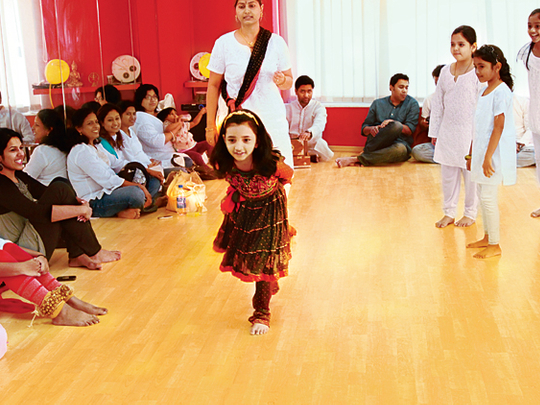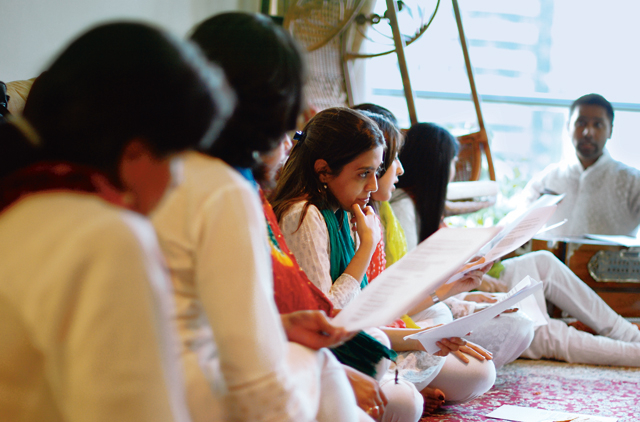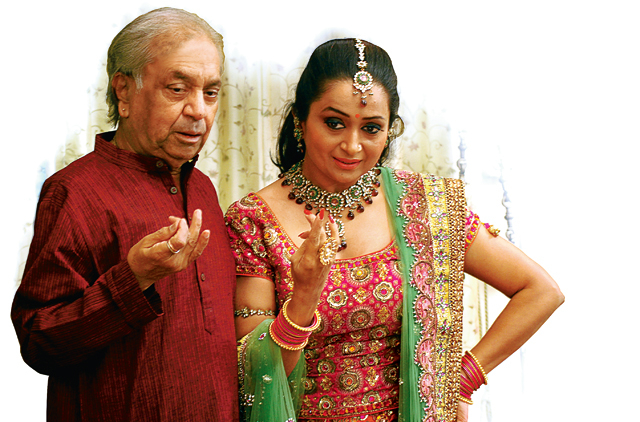
Two millennia ago, the legendary sage Bharata Muni first enunciated the basics of India's performing arts in a treatise called Natya Shastra. While the revered musicologist sat under the shade of a cool banyan tree, pondering upon different dance movements, did he know that he was formulating a philosophy that would continue to inspire the living universe centuries after his death?
These traditional performing art forms have now taken on a life of their own — not just surviving centuries of subjugation by foreign influences but also thriving by incorporation. And as patrons of Indian dance, music and theatre have flown their nests and settled outside the subcontinent, so have they carried with them the cultural baggage that sets them apart in their adopted homelands.
Educating outsiders about their heritage and meeting with people who share similar passions becomes the raison d'être of expatriates who have a knack for the arts. And the need to create a familiar world around oneself is strong. For most Indians, that would mean Indian food, music, dance, theatre and movies — not necessarily in that order.
One such need gave birth to Gurukul, a Dubai-based organisation that provides training in Indian dance forms andholds regular dance performances at Dubai Community Theatre and Arts Centre at Mall of the Emirates (Ductac).
Passion leads to action
When Gurukul's kathak teacher, Pali Chandra, moved to the UAE from the UK in 2005, several of her ex-students seized the opportunity to continue their lessons under her guidance. Six years later, the venture is a full-fledged programme that trains students aged anywhere between five and 50 years, and of varying levels of proficiency. "A lot of our students [come from] mixed ethnic backgrounds of Indian and Pakistani origin, having lived outside the subcontinent for generations," says Somna Tugnait, Director Projects, Gurukul. "They want to remain connected to their culture — what better a way than to dance into it!" In June this year, the group organised a three-day Kathak Festival, bringing Pandit Birju Maharaj to the UAE, and providing students a unique opportunity to interact with the veteran kathak dancer, choreographer and vocalist.
Malhaar Choir, the first Indian music group in the Middle East, is a non-profit body of working professionals from different walks of life, strung together by a passion for Indian classical and folk music. "Through my interactions with people in the UAE, I realised that there is a misconception that Indian music means Bollywood music," laments founder Jogiraj Sikidar, who is a prolific Hindustani musician. "I saw [the choir] as an opportunity and a challenge to leverage the rich legacy of Indian music." The group has more than 35 members, but it isn't very easy to join the choir, because the minimum — and perhaps only — criterion is heartfelt dedication to music. Pointer to all bathroom singers wanting to go pro: it doesn't happen overnight.
Cultural showcase
So what drives these denizens to such cultural commitments? "Our only aim is to showcase India's rich cultural heritage among other expatriates," Sikidar says. Deshantari Dubai, a Bengali socio-cultural non-profit group of professional artists organising year-round quality cultural programmes in the emirate, believes its programmes bring the culture-conscious Bengali community together, and gives them a platform to celebrate their rich heritage. "Staying away from India, our children are almost out of touch with the Bengali culture, hence having such a group that nurtures their inbuilt talents is a necessity. The younger generation can then cultivate this culture further and take it forward," Deshantari's Founder Meenakshi Chakraborthy feels. "These programmes make you feel right at home." Although the venture is yet to take on titanic proportions, it is fairly popular with the growing Bengali community in Dubai. For a relatively meagre fee of Dh30, you can celebrate Independence Day today, the Bengali way, with Deshantari Dubai at Al Ghozlan Community Hall in The Greens. For details, email deshantari.dubai@gmail.com
Plenty of local fish
It is often believed that there's a dearth of home-brewed talent in the UAE. This misconception is reinforced every time international cultural troupes are invited to perform here. "The UAE has a rich pool of talent and one needs to believe in these artists. When we go to meet any prospective sponsor, we face a lot of scepticism and suspicion," says Malhaar's Sikidar.
Besides, the opinion that there's a lack of talent in the country, only seems to exist in the outside world. Ask the insiders of the trade and they'll tell you a different story.
Ketaki Hazra has been a resident of Dubai for 30 years now, and teaching various Indian dance forms to obliging expatriates has been her forte. The winner of many awards, including the All India Dance Competition at Allahabad, says, "It's completely baseless to say that the UAE is devoid of talent, especially when one can see dancers trained here going abroad and gaining due recognition. I have students who have gone back to India, competed with residents and won competitions against them, and then some who have established themselves as dance exponents in the West." When asked if performers in Dubai are up to the mark, she says dance is an art form that evolves with time. "It won't be wrong to say that Indian dance forms in the UAE are evolving at the same rate that they are in India," she says.
If you're an ardent follower of classical Indian performances in the UAE, then you would know of the early July auditions held by Maayavi, a travelling dance drama tour, for its dance programme ‘Piya Bawari' (September 29, Ductac). Candidates who passed the auditions paid a participation fee that includes a three month-long workshop with lessons in dance, costume, make-up, choreography and performance on stage. Dance forms have always evolved to meet the needs of the region and the times. While purists might turn up their noses over mixing of different traditional forms and structure, there are those in India and abroad who will always stand for adaptation, change and creativity.
Gurukul's Pali Chandra incorporates elements of flamenco, tap dance, Western contemporary dance, ballet as well as bharatanatyam into her kathak performances. Apart from creating something unique and original, this also helps attract a wider scope of audience, owing to Dubai's multicultural setting. Besides this a mix of different influences in dance, Gurukul also offers classes in the unique Yoga Dance — an innovative mix of dance with yet another age-old Indian tradition, yoga. Given how leading health gurus, (read Jennifer Aniston and Geri Halliwell) vouch for yoga these days, it's no wonder that these classes are receiving a great response. Regional influences also seep through in another Gurukul offering, Contemporary Kathak. "It's rooted in the classical genre, with upbeat music and contemporary themes that people of today can appreciate and relate to easily," explains Tugnait.
Adapt and evolve
Malhaar's intelligent marketing not only invites all Indians to participate, but even spikes it with regional and Western interest. "Malhaar performs all genres of Indian music that are adapted to western choral music style — be it an intricate Indian classical composition or colourful folk and patriotic songs in different Indian languages," says Sikidar. Malhaar's most recent show ‘Jashn-e-Awadh' was a celebration of sufi music. The performance was based on the famous patron of the arts, Nawab Wajid Ali Shah of Lucknow, and most of the play's lyrical contributions came from the nawab. The choice of subject obviously connects very well with the strong Islamic influence in the region.
Next on Malhaar's event calendar is a unique concept, Whitelight Unplugged, a series of house concerts under the full moon sky and without booming loudspeakers. On October 14 this year, Malhaar plans to organise another dance and music soirée, ‘O Ganga', a tale of how musical notes vary along the river Ganges in India. A journey that starts in the deep labyrinths of the Himalayas and ends in the Bay of Bengal.
But all said and done, is there enough money in the Indian classical arts to keep these organisations afloat? How do they make their money? All members of Malhaar, for one, bring a professional skill to the group that allows it to function as a self-sustained unit when working on a musical production. This of course saves costs as well.
"In-house marketing and sales specialists take over the responsibility of selling the product to sponsors. Our member architects do the set design. Graphic artists design collateral print materials and researchers and copy writers take control of the communication material," explains Sikidar. Some members put in money, but most expenses are met by sponsors and ticket sales.
Anyone culturally inclined can join Deshantari Dubai. For programmes of a larger scale, sponsors are roped in. The smaller events depend on contribution of attendees. Maayavi has charged participants a fee of Dh1,000 for its show, Piya Bawari, and sells tickets of the performance to stay afloat. Gurukul charges its students a fee per class, depending on the level of their proficiency and the location of the class — Ductac is slightly more expensive than Pearl Residence in Bur Dubai. But is that enough to sustain them? "It has been a long hard journey to give quality teaching in the right environment. That comes with a price tag. We have other investments that keep the ball rolling at home, so we don't have to depend on the earnings from Gurukul," says Tugnait.
However, no public performance can be economically viable if there are no viewers. So, is there an audience in the UAE that patronises these performances? "The presence of Indian art forms [in the UAE] is finally being felt, I think," says Tugnait. "Our three-day Kathak Festival stands testimony to that. All three days we were sold out well in advance." And with Pandit Birju Maharaj making an appearance, that's no surprise really.
Put on your red shoes
India is slowly awakening to the possibilities of marketing its culture. A Pune-based businesswoman and Bharat Natyam dancer Meghana Sabade, in collaboration with veteran dancer and dance guru Swati Daithankar, has formulated special tours, Nrutya Yatri, which will highlight dance destinations in India. The tours will cover a mix of established dance festivals, such as those held in Khajuraho and Chennai, age-old seats of learning the art including Santiniketan (kolakta), kalamandalam (kerela) and off-the-beaten-track options. Activities will include watching professional performances, appreciating the history behind art forms and even joining in the action by taking a few classes and attending dance seminars and workshops.
Dance across India
India is slowly awakening to the possibilities of marketing its culture. A Pune-based businesswoman and bharatnatyam dancer, Meghana Sabade, in collaboration with veteran dancer and dance guru Swati Daithankar, has formulated special tours called Nrutya Yatri to highlight dance destinations in India.
The tours will cover a mix of established dance festivals, such as those held in Khajuraho and Chennai, age-old seats of learning the art, including Santiniketan (West Bengal), Kalamandalam (Kerala) and off-the-beaten-track options. Activities include watching performances, and even taking a few classes and attending dance seminars. For more information call +91 20 305 6 8888/7/6/5 or mail info@guardianholidays.in










